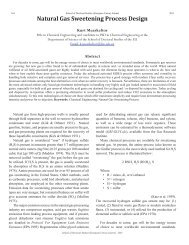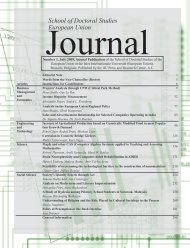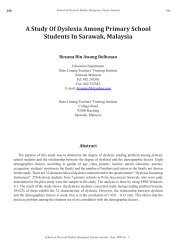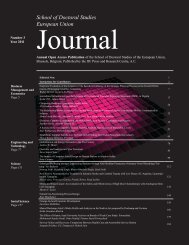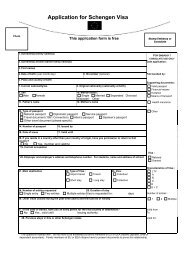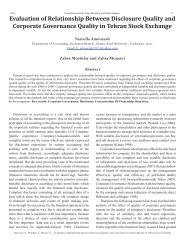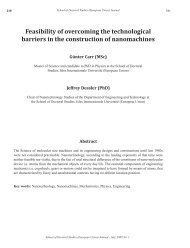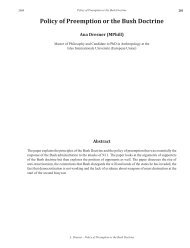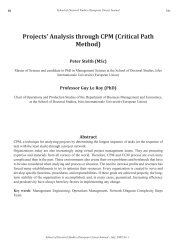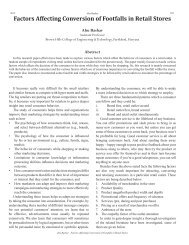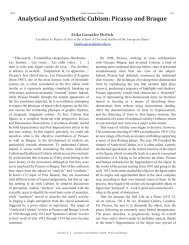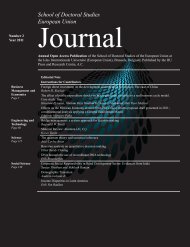Iiuedu.eu
Iiuedu.eu
Iiuedu.eu
Create successful ePaper yourself
Turn your PDF publications into a flip-book with our unique Google optimized e-Paper software.
24 School of Doctoral Studies (European Union) Journal2011Comparing Bankruptcy Prediction Models in IranAli Ebrahimi KordlarFaculty of management, Tehran university, Tehran, IranNader NikbakhtFaculty of management, Tehran university, Tehran, IranEmail: Nader.nikbakht66@gmail.comAbstractThis paper compares the predictive power of a number of previous research models on bankruptcy prediction in Tehran StockExchange (TSE) from 2001 to 2009. To compare the predictive power of these models, the adjusted R2 (as In-sample metric) androot mean squared error (RMSE), mean absolute error (MAE) and mean absolute percent error (MAPC) (as out-of-sample predictionmetrics). Finally, based on the estimation results of previous models in Iran, we present a final version logit type model that has higherperformance than other models. The empirical results of In-sample and out-of-sample prediction power indicate that our presented modelhas higher adjusted R2 and lower RMSE, lower MAE and lower MAPC, too. Key words: Bankruptcy prediction model, Logit model,Voung test, Tehran Stock Exchange. JEL classification codes: M41, C23Since Beaver (1966), an expanded literature onbankruptcy prediction has emerged, and its impact hasspilled into the commercial world, where it has been usedin the development of several commercially employedbankruptcy prediction models. Out of this literature havecome a number of competing empirical models withalternative explanatory variables and alternative statisticalmethodologies for model estimation.The dependent variable in these models is commonly adummy variable where ''firm filed for bankruptcy" is set to1 and other is set to 0. The independent variables are oftenaccounting ratios extracted from financial statements andinclude measures of profitability, liquidity, and leverage.Some studies also include market-based variables suchas the volatility of stock returns and past excess returns.The accounting-based models developed by Altman (1968)and Ohlson (1980) have emerged as the most popularbankruptcy prediction models and are often used byempirical accounting researchers as indicators of financialdistress.Altman (1968) employs multivariate discriminateanalysis (MDA) on a list of financial ratios to identifythose ratios that are statistically associated with futurebankruptcy. Ohlson (1980) uses a logit model, which usesless restrictive assumptions than those taken by the MDAapproach. Zmijewski (1984) adopts a probit approach thatis also based on accounting data but uses a different setof independent variables. All of these approaches predictfuture bankruptcy based on accounting ratios drawn fromfirm’s financial statements.More recently, Shumway (2001) has proposed a discretetimehazard model to predict a firm's bankruptcy usingboth accounting and market variables. The main differencebetween this model and the static logit model is that thehazard model can be estimated within the logit frameworkwhile using the entire life span of information (all firmyears)for each firm. By contrast, the static logit modelcan only incorporate one firm-year for each observation(i.e., each observation consists of a single set of variablesobserved at a single point in time).Another stream of the bankruptcy prediction literaturefocuses on market-based information. For example,Hillegeist et al. (2004) have developed a BSM-Probbankruptcy prediction model that is based on the Black-Scholes-Merton option-pricing model. Their resultsindicate that the BSM-Prob model outperforms the modelsof Altman (1968) and Ohlson (1980) in a series of tests.There are also a number of papers that propose variousfirm-characteristics that may be useful to future bankruptcyprediction. For instance, Rose (1992) presents a model offirm diversification in which managers use diversificationto reduce the risk of bankruptcy, particularly where theratio of the manager's firm-specific human capital to hisnon-firm-specific human capital is high. Denis et al. (1997)measure corporate diversification by the number of businesssegments. Beaver et al. (2005) propose that, other thingsSchool of Doctoral Studies (European Union) Journal - 2011



